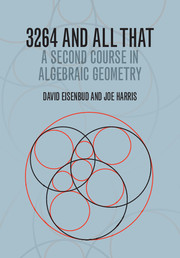Book contents
- Frontmatter
- Contents
- Preface
- Chapter 0 Introduction
- Chapter 1 Introducing the Chow ring
- Chapter 2 First examples
- Chapter 3 Introduction to Grassmannians and lines in ℙ3
- Chapter 4 Grassmannians in general
- Chapter 5 Chern classes
- Chapter 6 Lines on hypersurfaces
- Chapter 7 Singular elements of linear series
- Chapter 8 Compactifying parameter spaces
- Chapter 9 Projective bundles and their Chow rings
- Chapter 10 Segre classes and varieties of linear spaces
- Chapter 11 Contact problems
- Chapter 12 Porteous' formula
- Chapter 13 Excess intersections and the Chow ring of a blow-up
- Chapter 14 The Grothendieck Riemann–Roch theorem
- Appendix A The moving lemma
- Appendix B Direct images, cohomology and base change
- Appendix C Topology of algebraic varieties
- Appendix D Maps from curves to projective space
- References
- Index
Chapter 6 - Lines on hypersurfaces
Published online by Cambridge University Press: 05 March 2016
- Frontmatter
- Contents
- Preface
- Chapter 0 Introduction
- Chapter 1 Introducing the Chow ring
- Chapter 2 First examples
- Chapter 3 Introduction to Grassmannians and lines in ℙ3
- Chapter 4 Grassmannians in general
- Chapter 5 Chern classes
- Chapter 6 Lines on hypersurfaces
- Chapter 7 Singular elements of linear series
- Chapter 8 Compactifying parameter spaces
- Chapter 9 Projective bundles and their Chow rings
- Chapter 10 Segre classes and varieties of linear spaces
- Chapter 11 Contact problems
- Chapter 12 Porteous' formula
- Chapter 13 Excess intersections and the Chow ring of a blow-up
- Chapter 14 The Grothendieck Riemann–Roch theorem
- Appendix A The moving lemma
- Appendix B Direct images, cohomology and base change
- Appendix C Topology of algebraic varieties
- Appendix D Maps from curves to projective space
- References
- Index
Summary
Keynote Questions
(a) Let X ⊂ ℙ4 be a general quintic hypersurface. How many lines L ⊂ ℙ4 does X contain? (Answer on page 228.)
(b) Let {Xt ⊂ ℙ3}t∈ℙ1 be a general pencil of quartic surfaces. How many of the surfaces Xt contain a line? (Answer on page 233.)
(c) Let {Xt ⊂ ℙ3}t∈ℙ1 be a general pencil of cubic surfaces, and consider the locus C ⊂ (1, 3) of all lines L ⊂ ℙ3 that are contained in some member of this family. What is the genus of C? What is the degree of the surface S ⊂ ℙ3 swept out by these lines? (Answers on pages 233 and 233.)
(d) Can a smooth quartic hypersurface in ℙ4 contain a two-parameter family of lines? (Answer on page 238.)
In this chapter we will study the schemes parametrizing lines (and planes of higher dimension) on a hypersurface. These are called Fano schemes. There are two phases to the treatment. It turns out that the enumerative content of the keynote questions above, and many others, can be answered through a single type of Chern class computation. But there is another side of the story, involving beautiful and important techniques for working with the tangent spaces of Hilbert schemes, of which Fano schemes are examples. These ideas will allow us to verify that the “numbers” we compute really correspond to the geometry that they are meant to reflect. We will go even beyond these techniques and explore a little of the local structure of the Fano scheme. There are many open questions in this area, and the chapter ends with an exploration of one of them.
What to expect
For what n and d should we expect a general hypersurface X ⊂ ℙn of degree d to contain lines? What is the dimension of the family of lines we would expect it to contain? When the dimension is zero, how many lines will there be?
To answer these questions, we introduce in this chapter a fundamental object, the Fano scheme Fk(X) ⊂ G(k,n) parametrizing k-planes on X, and then study its geometry.
- Type
- Chapter
- Information
- 3264 and All ThatA Second Course in Algebraic Geometry, pp. 193 - 243Publisher: Cambridge University PressPrint publication year: 2016

